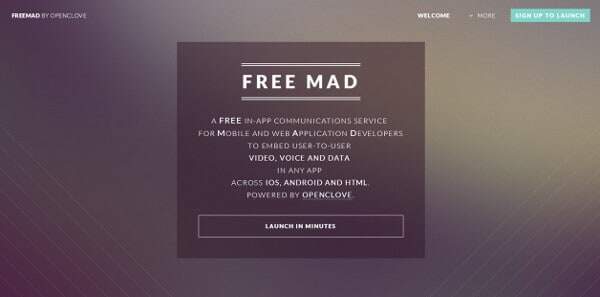OpenClove has a new free service to attract customers. It is an interesting but risky attempt by OpenClove.

The WebRTC Platform API space is heating up. Vendors are prettying themselves up for acquisitions or investments. One of the recent moves came from OpenClove – a known platform vendor with some interesting video capabilities. What they launched is a service called FreeMAD. As explained on its website:
FreeMAD: A free in-app communications service for Mobile and web Application Developers to embed user-to-user video, voice and data in any app across iOS, Android and HTML.
At around the same time, OpenClove has renamed their platform from OVX to OpenClove SCaaS: Secure Communications as a Service.
FreeMAD can be seen as the freemium model of OpenClove SCaaS – it most probably just the same service running on the same infrastructure with premium features disabled.
The interesting part is what got included in FreeMAD and what was left out of it.
Included
The focus here is mainly on mobile-first.
- iOS and Android SDKs are available for free
- 1:1 voice and video calls are enabled for free
- HTML is available (translation: Chrome and Firefox)
Left out
- Plugin for IE5 and Safari (that is unavailable from OpenClove at the moment even in the premium version)
- Multipoint, which is supported in the paid for service
- Recording and other advanced capabilities, again – left for the paid for service
OpenClove’s Challenges
This move by OpenClove is a rather risky proposition. On one hand, this can be a great way to attract mobile-first or mobile-only services, where the focus is on… mobile. You get many developer on boarded quickly, developing their proof of concepts or even full-fledged services. You show nice growth numbers and you’re done. Sort-of.
I am sure the guys at OpenClove were thinking of WhatsApp with this move – growing up fast, getting traction – and then selling it to someone with deep pockets. But this distinction is harder when your target audience are developers. I don’t think they act like WhatsApp’s customers.
A few challenges along the way:
- With 10-20% of the calls getting routed via TURN, there’s bandwidth and server costs that OpenClove needs to take upon itself. If these services are good enough and never need to go for a paid for service, then OpenClove are in for a real headache (and money-drainer). This one is pretty hard to scale cost-wise
- Developers are fickle creatures. They may start with one service (OpenClove) and then move to another when they get funding to build their app from the proof of concept they invested in. What percentage of those using OpenClove will head there? Who knows
- GIPS (the Google acquisition that lead to WebRTC’s media engine technology) once tried a free version of its GIPS media engine, but soon found out it doesn’t work. Developers weren’t converting to the paid version, and they were taxing GIPS’ support too much. They ended up scrapping that initiative
- What guarantees are there that this won’t happen here?
- Sending free-riders to a forum and letting them handle their own issues is nice, but someone still needs to keep the lights on there and answer questions. Not doing so can backfire big time
- This can lead potential paying customers to the free version, reducing revenue. I can even think of scenarios where a customer uses a paid for account in parallel to a free account just to reduce costs on a single production service (but that just might be my Jewish upbringing doing the thinking)
- Missing IE (in early beta) and Safari (in development) plugins. This gap needs to be closed – especially when Temasys just commoditized the plugin challenge of WebRTC
On the upside, if this works – OpenClove may find itself with hundreds or thousands of developers a year from now with interesting use cases running on their infrastructure – which is a definite win.
Why is this important
WebRTC is hard to monetize. WebRTC API Platforms are abundant, and they are making interesting moves lately. On the other hand, a long of potential customers are now thinking of building their own infrastructure, especially after Snapchat’s acquisition of AddLive.
This proposition will put pressure on other platform vendors to come up with their own creative ways to entice developers to use their platform.
Expect more announcements during June from other players in the WebRTC API space.
